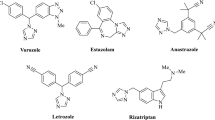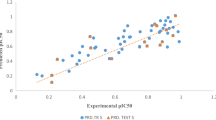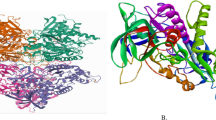Abstract
Alzheimer’s disease is a widespread type of neurodegenerative dementia that mainly affects the elderly. Currently, this disease can only be treated palliatively. Existing drugs can only improve patients’ symptoms. The search for new drugs that can effectively treat this disease is an important field of research in medicinal chemistry. Here we report a structure–activity relationship study of tacrine and some of its analogues in relation to their inhibitory activities against Alzheimer’s disease. All of the molecular descriptors were calculated at the M062X/6–311++G(d,p) level of theory. Principal component analysis of the molecular descriptors showed that the compounds could be categorized into active and inactive compounds using just two descriptors: the HOMO and LUMO energies. These results should help us to explain the activities of tacrine derivatives and to model new tacrine analogues that are active against Alzheimer’s disease.

PCA score plot for tacrine and its analogues
Similar content being viewed by others
Avoid common mistakes on your manuscript.
Introduction
Alzheimer’s disease (AD) is a chronic neurodegenerative disorder characterized by progressive dementia, including losses of memory and cognitive capacity, which affects the ability of those afflicted with AD to perform everyday activities. In the later stages of the disease, patients cannot carry out simple tasks such as walking and swallowing, and AD can ultimately lead to death [1,2,3]. Risk factors include (among others) aging, family history, fewer years of formal education, and cardiovascular disease [4]. Worldwide, more than 35 million people currently have AD, but this figure is expected to increase threefold by 2050 [3]. Various causes of AD have been proposed, including amyloid-β deposits [5], oxidative stress [6], and low levels of acetylcholine [2, 7, 8].
Although the FDA (U.S. Food and Drug Administration) has approved six new drugs for the treatment of AD, there is no drug that can stop or slow down neuron death. These drugs are only able to improve the symptoms of AD [4]; they are not able to heal AD patients. One of the drugs approved for the treatment of AD is 1,2,3,4-tetrahydroacridin-9-amine (tacrine) [9]. Tacrine was first investigated in a project to find new antibacterial drugs to treat soldiers in the Second World War. Although it did not present antibacterial activity, further studies showed that tacrine was able to inhibit the enzyme acetylcholinesterase (AChE) [9,10,11,12].
As mentioned above, a low level of acetylcholine is strongly correlated with Alzheimer’s disease. The main cause of acetylcholine depletion is AChE activity. AChE is responsible for the hydrolysis of acetylcholine to the inactive metabolites choline and acetate [9, 13]. As a consequence of the activity of tacrine against AChE, tacrine was patented in 1989 as an AD treatment, and in 1993 it became the first medicine to be approved by the FDA for the treatment of AD [9, 13]. However, this medicine is not currently used to treat AD patients due to its severe side effects and hepatotoxicity. That said, tacrine can still be used as a model to generate new derivatives that are active against Alzheimer’s disease but produce no side effects [14, 15].
Proctor and Harvey demonstrated that a complex forms between tacrine and AChE due to van der Waals interactions and charge transfer involving π electrons at the peripheral site on the enzyme. The catalytic site of AChE participates in electrostatic π−π stacking interactions with the amino acids tryptophan and phenylamine. Tacrine also hydrogen bonds with histidine [16].
Due to the absence of a medicine that can eliminate AD, many scientists around the world have focused their research on finding new drugs that are efficient against AD. Many AChE inhibitors have been reported in the literature, including analogues of tacrine [10,11,12,13, 17,18,19].
In this context, Samadi and coworkers [8] estimated the IC50 values of tacrine and 12 of its analogues against AD; see Table 1. Three compounds (9, 10, and 12) were found to be inactive (IC50 > 100 μM) against AD, while 10 compounds (1–8, 11, and 13) were considered to be active against AD (IC50 < 100 μM).
Considering the results found by Samadi and coworkers [8], the aim of the present work was to establish the relationships between inhibitory activity against Alzheimer’s disease and various molecular descriptors of the tacrine-based compounds investigated by Samadi and coworkers [8]. For this purpose, geometric and electronic molecular descriptors of those molecules were calculated at the M062X/6–311++G(d,p) level of theory, and the resulting data were probed using principal component analysis (PCA).
Computational procedure
Molecular descriptors
Some of the tacrine derivatives considered in this work—namely, compounds 2, 3, 4, 5, 8, 10, 11, and 12—have rotational degrees of freedom in their substituent groups. In the absence of experimentally determined structures for these compounds, and in order to compare all of the compounds on the same footing, it was necessary to carry out a search to find the conformation of each compound with the lowest energy. This procedure was carried out using the semiempirical quantum chemical method Austin Model 1 [20].
The lowest-energy conformation of each molecule was further optimized with the Gaussian G09 [21] software package. All calculations were carried out using the exchange-correlation functional M062X [22] and the basis set 6–311++G(d,p).
Partial atomic charges (C) were calculated based on the electrostatic potential (CHELPG) according to the method proposed by Breneman and Wiberg [23]. Bond lengths, bond angles, and dihedral angles were obtained at the same level of theory, and molecular dipole moments (μ) were calculated via
where ρ(r) is the electronic density. The frontier molecular orbital energies (EHOMO and ELUMO) were obtained using the Kohn–Sham method [24], and hardness (η) [25,26,27] values were calculated according to
Energy gap values were derived as
In addition, the molecular volume (V), polarizability (α), and partition coefficient (logP, where P is the ratio of the concentrations of a given substance in two mixed immiscible liquids in equilibrium) were also calculated.
Selection of descriptors
To correlate the molecular descriptors of tacrine and its analogues with their inhibitory activities against Alzheimer’s disease, the data were first autoscaled, i.e., the data were mean-centered and divided by the standard deviation. This preprocessing procedure ensured that all of the molecular descriptors were compared on the same scale, i.e., all descriptors assumed the same importance in the PCA. Initially, to get an idea of the best descriptors to use in the PCA, we performed a Fisher weights analysis. This involved calculating the ratio of the square of the interclass means to the sum of the intraclass variances [28]:
The descriptors with the highest Fisher weights are the best descriptors to use in a PCA. After calculating the Fisher weights for all descriptors, we finally performed a PCA of the variables selected according to their Fisher weights. PCA is a technique that creates new variables that are linear combinations of the original variables. PC1 was chosen to be the principal component with the largest variance, PC2 was chosen to be the principal component with the second largest variance, and so on [29]. The aim of PCA is to reduce the dimensionality of the data set; in other words, only those descriptors that are important for distinguishing between the compounds in the active and inactive classes are retained.
Results and discussion
Structure 13 in Table 1 shows the atom numbering scheme used during the calculations of the molecular descriptors. After many attempts, PCA of the selected descriptors indicated that two molecular descriptors (EHOMO and ELUMO) were able to completely discriminate between the active and inactive compounds. In Fig. 1a, we can see that the active compounds are on the left hand side and the inactive compounds are on the right hand side. Indeed, we can draw a vertical line that separates the two groups. Figure 1a also shows that PC1 alone is responsible for the discrimination; it accounts for about 90% of the total variance in the data. PC1 and PC2 together account for 100% of the variance.
It is important to note that our results agree with the conclusions of the studies reported in [15, 16], which state that the HOMO and LUMO energies of a compound are important influences on its inhibitory activity towards AChE. Table 2 shows that the HOMO and LUMO energies are both negative. According to the following equation that describes PC1, a molecule must have high (i.e., relatively positive) HOMO and LUMO energies to be classified as active:
It is worth noting that, for the first and second principal components, the absolute values of the loadings for the HOMO and LUMO energies are equal. However, while the loadings have the same sign for PC1, they have the opposite signs for PC2, as shown below:
Many studies [19, 24, 30] have shown that the frontier molecular orbitals play an important role in chemical reactions. These orbitals are also responsible for the formation of many charge-transfer complexes. Molecules with more positive HOMO energies are more ionizable; i.e., they remain relatively stable when they donate an electron, making them more susceptible to electrophilic attack.
For the compounds listed in Table 1, substitution reactions mainly occur at positions 1, 2, 6, and 12. Reddy et al. stated that changes at position 6 affect the inhibitory activity of the compound towards AChE [15]. Tacrine binds at the catalytically active site of AChE [8], but changes at position 12 cause tacrine to bind at the peripheral anionic site of the enzyme [15]. Tacrine-trolox hybrids were found to be able to bind at both the catalytically active site and the peripheral site of AChE, inhibiting the enzyme [31].
Besides experimental studies, there have also been theoretical investigations of the inhibition of AChE by tacrine. Eslami and coworkers studied the inhibition of AChE by the cystamine-tacrine dimer via classic molecular dynamics. They noticed that the dimer interacted with residues in the active site of the enzyme via hydrogen bonding [32].
Therefore, based on the results of the present work and those obtained in experimental and other theoretical studies, the frontier molecular orbital energies of a tacrine-based compound are clearly a major influence on the mechanism it uses to inhibit the action of AChE. Also, AChE inhibition occurs due to the formation of a chemical bond or hydrogen bond between AChE and the tacrine-based compound.
However, the most important conclusion of the present work is that Eq. 5 can be used to guide the design of new tacrine-based compounds that are active against Alzheimer’s disease.
Conclusions
PCA of the molecular descriptors of tacrine-based compounds, as calculated at the M062X/6–311++G(d,p) level of theory, showed that two descriptors—the HOMO and LUMO energies—can be used to categorize such compounds into two classes: compounds that show inhibitory activity towards AChE (“active compounds”) and those that do not (“inactive compounds”). The results of the PCA showed that PC1 alone is responsible for this separation into two classes, as it accounts for about 90% of the variance in the data. For a compound to be classified as active, it must have high (i.e., relatively positive) HOMO and LUMO energies. As the frontier molecular orbitals are important influences on many chemical reactions and the formation of various complexes, they must be considered when attempting to explain the inhibitory activities of tacrine and its derivatives towards AChE. Also, the equation derived in this work for PC1 should facilitate the design of new tacrine derivatives that are active against Alzheimer’s disease.
References
McKhann G, Drachman D, Folstein M et al (1984) Clinical diagnosis of Alzheimer’s disease: report of the NINCDS-ADRDA Work Group under the auspices of Department of Health and Human Services Task Force on Alzheimer’s Disease. Neurology 34:939–944
Thiratmatrakul S, Yenjai C, Waiwut P, Vajragupta O, Reubroycharoen P et al (2014) Synthesis, biological evaluation and molecular modeling study of novel tacrine-carbazole hybrids as potential multifunctional agents for the treatment of Alzheimer’s disease. Eur J Med Chem 75:21–30
Keri RS, Quintanova C, Chaves S, Silva DF, Cardoso SM et al (2016) New tacrine hybrids with natural-based cysteine derivatives as multitargeted drugs for potential treatment of Alzheimer’s disease. Chem Biol Drug Des 87:101–111
Alzheimer’s Association (2016) 2016 Alzheimer’s disease facts and figures. Alzheimers Dement 12:459–509
Qiang W, Yau W-M, Lu J-X, Collinge J, Tycko R (2017) Structural variation in amyloid-β fibrils from Alzheimer’s disease clinical subtypes. Nature 541:217–221
Perry G, Cash AD, Smith M (2002) Alzheimer disease and oxidative stress. J Biomed Biotechnol 2:120–123
Brühlmann C, Ooms F, Carrupt P-AA, Testa B, Catto M et al (2001) Coumarins derivatives as dual inhibitors of acetylcholinesterase and monoamine oxidase. J Med Chem 44:3195–3198
Samadi A, Valderas C, Ríos CDL, Bastida A, Chioua M et al (2011) Cholinergic and neuroprotective drugs for the treatment of Alzheimer and neuronal vascular diseases. II. Synthesis, biological assessment, and molecular modelling of new tacrine analogues from highly substituted 2-aminopyridine-3-carbonitriles. Bioorg Med Chem 19:122–133
Jarrott B (2016) Tacrine: in vivo veritas. Pharmacol Res 116:29–31
Tai K, Shen T, Börjesson U, Philippopoulos M, McCammon JA et al (2001) Analysis of a 10-ns molecular dynamics simulation of mouse acetylcholinesterase. Biophys J 81:715–724
Bautista-Aguilera OM, Esteban G, Bolea I, Nikolic K, Agbaba D et al (2014) Design, synthesis, pharmacological evaluation, QSAR analysis, molecular modeling and ADMET of novel donepezil-indolyl hybrids as multipotent cholinesterase/monoamine oxidase inhibitors for the potential treatment of Alzheimer’s disease. Eur J Med Chem 75:82–95
Gholivand K, Ebrahimi Valmoozi AA, Mahzouni HR, Ghadimi S, Rahimi R (2013) Molecular docking and QSAR studies: noncovalent interaction between acephate analogous and the receptor site of human acetylcholinesterase. J Agric Food Chem 61:6776–6785
Castilho MS, Guido R, Andricopulo AD (2007) Classical and hologram QSAR studies on a series of tacrine derivatives as butyrylcholinesterase inhibitors. Lett Drug Des Discov 4:106–113
Jeřábek J, Uliassi E, Guidotti L, Korábečný J, Soukup O et al (2017) Tacrine-resveratrol fused hybrids as multi-target-directed ligands against Alzheimer’s disease. Eur J Med Chem 127:250–262
Reddy EK, Remya C, Mantosh K, Sajith AM, Omkumar RV et al (2017) Novel tacrine derivatives exhibiting improved acetylcholinesterase inhibition: design, synthesis and biological evaluation. Eur J Med Chem 139:367–377
Proctor GR, Harvey AL (2000) Synthesis of tacrine analogues and their structure-activity relationships. Curr Med Chem 7:295–302
Nascimento ECM, Martins JBL, dos Santos ML, Gargano R (2008) Theoretical study of classical acetylcholinesterase inhibitors. Chem Phys Lett 458:285–289
Nascimento ECM, Martins JBL (2011) Electronic structure and PCA analysis of covalent and non-covalent acetylcholinesterase inhibitors. J Mol Model 17:1371–1379
Alam M, Lee DU (2016) Synthesis, spectroscopic and computational studies of 2-(thiophen-2-yl)-2,3-dihydro-1H-perimidine: an enzymes inhibition study. Comput Biol Chem 64:185–201
Dewar MJS, Zoebisch EG, Healy EF, Stewart JJP (1985) Development and use of quantum mechanical molecular models. 76. AM1: a new general purpose quantum mechanical molecular model. J Am Chem Soc 107:3902–3909
Frisch MJ, Trucks GW, Schlegel HB, Scuseria GE, Robb MA et al (2009) Gaussian 09, revision A.02. Gaussian, Inc., Wallingford
Kohn W, Becke AD, Parr RG (1996) Density functional theory of electronic structure. J Phys Chem 100:12974–12980
Breneman CM, Wiberg KB (1990) Determining atom-centered monopoles from molecular electrostatic potentials. The need for high sampling density in formamide conformational analysis. J Comput Chem 11:361–373
Karelson M, Lobanov VS, Katritzky AR (1996) Quantum-chemical descriptors in QSAR/QSPR studies. Chem Rev 96:1027–1044
Camargo AJ, Honório KM, Mercadante R, Molfetta FA, Alves CN et al (2003) A study of neolignan compounds with biological activity against Paracoccidioides brasiliensis by using quantum chemical and chemometric methods. J Braz Chem Soc 14:809–814
Camargo LTFM, Sena MMM, Camargo AJJ (2009) A quantum chemical and chemometrical study of indolo[2,1-b]quinazoline and their analogues with cytotoxic activity against breast cancer cells. SAR QSAR Environ Res 20:537–549
Martins GR, Napolitano HB, Camargo LTFM, Camargo AJ (2012) Structure-activity relationship study of rutaecarpine analogous active against central nervous system cancer. J Braz Chem Soc 23:2183–2190
Sharaf MA, Illman DL, Kowalski BR (1986) Chemometrics. Wiley, New York
Jolliffe IT (1986) Principal Component Analysis. Springer, Berlin. Book, v 2, p 37–52
Acar N, Selçuki C, Coşkun E (2017) DFT and TDDFT investigation of the Schiff base formed by tacrine and saccharin. J Mol Model 23:17
Nepovimova E, Korabecny J, Dolezal R, Babkova K, Ondrejicek A et al (2015) Tacrine-trolox hybrids: a novel class of centrally active, nonhepatotoxic multi-target-directed ligands exerting anticholinesterase and antioxidant activities with low in vivo toxicity. J Med Chem 58:8985–9003
Eslami M, Hashemianzadeh SM, Bagherzadeh K, Seyed Sajadi SA (2016) Molecular perception of interactions between bis(7)tacrine and cystamine-tacrine dimer with cholinesterases as the promising proposed agents for the treatment of Alzheimer’s disease. J Biomol Struct Dyn 34:855–869
Acknowledgements
The authors acknowledge the Fund for Research Support of the State of Goiás (FAPEG) and the High-Performance Computing Center at the Universidade Estadual de Goiás (UEG).
Author information
Authors and Affiliations
Corresponding author
Additional information
Publisher’s note
Springer Nature remains neutral with regard to jurisdictional claims in published maps and institutional affiliations.
This paper belongs to the Topical Collection VII Symposium on Electronic Structure and Molecular Dynamics—VII SeedMol
Rights and permissions
About this article
Cite this article
Vieira, I., Camargo, L.T.F.M., Ribeiro, L. et al. Structure–activity relationship of tacrine and its analogues in relation to inhibitory activity against Alzheimer’s disease. J Mol Model 25, 116 (2019). https://doi.org/10.1007/s00894-019-3993-8
Received:
Accepted:
Published:
DOI: https://doi.org/10.1007/s00894-019-3993-8





